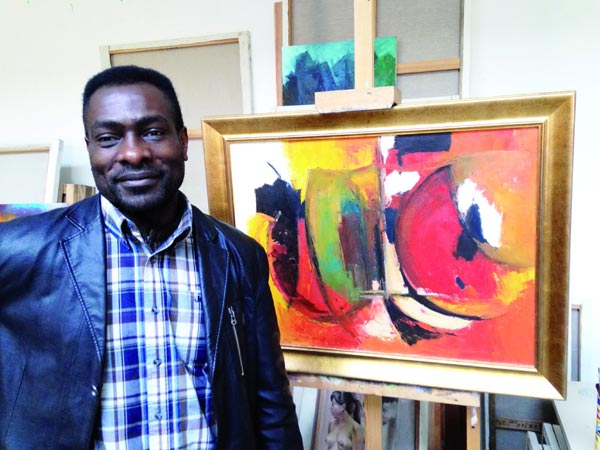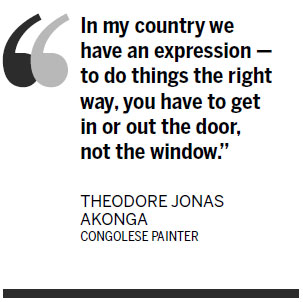
"I use my paintings to make people think," Akonga says. "We can help the cultures understand each other better."
Akonga came to China after receiving a scholarship to study at the Central Academy of Fine Arts. He is close to completing a PhD, and his studio space at CAFA is a riot of color and shapes - a clutter of canvases that range from nude models from his life-drawing classes to portraits of Congolese leaders to intriguing blends of Chinese and African symbolism.
"I draw on inspiration from Chinese characters," he says.
In one piece, he infused the Chinese character for "door" (men) with a layer of meaning from Africa.
"In my country we have an expression - to do things the right way, you have to get in or out the door, not the window."
Among the other paintings that clutter his workspace is a self-portrait, featuring the Great Wall both on his shirt and in the background. It is an exploration of retaining a sense of self and cultural identity while immersed in a foreign country.
It is one of two paintings in the room that are not for sale.

The other is his personal favorite, a red and gold dominated abstract titled Conviction. Unlike his other works, which have evolved over long periods of creation, that painting came together in a sudden, frenzy of inspiration - at a time when he was mired in self-doubt about his future as an artist.
"It dispelled all of my weariness and I felt like I could start a new life," he says.
"For most of my paintings, I can tell you the story behind them," he adds with a slow smile. "For this one, I tell you frankly, I have no idea what it means."
Beijing artist Xie Fei, who has worked with Akonga in the past, loves the African painter's use of bold colors, which lend a strong African flavor, and his tendency to infuse different cultural elements in his work.
"It makes the finished product modern and international," Xie says.
Akonga is contemplating a return to his African homeland when his studies are complete next year. Having brought something of Africa to China, he now hopes to bring a new understanding of China back to Africa.
"Sometimes the most helpful people are people like us," says his friend Njoku. "We are a product of both cultures."
Akonga picks up a pen and begins to doodle on a notepad. He draws the Chinese character men that has featured so prominently in his work.
It looks like an open door. It looks both African and Chinese. It looks like a way into the future.
|
|
|
|
|
|
|
|
